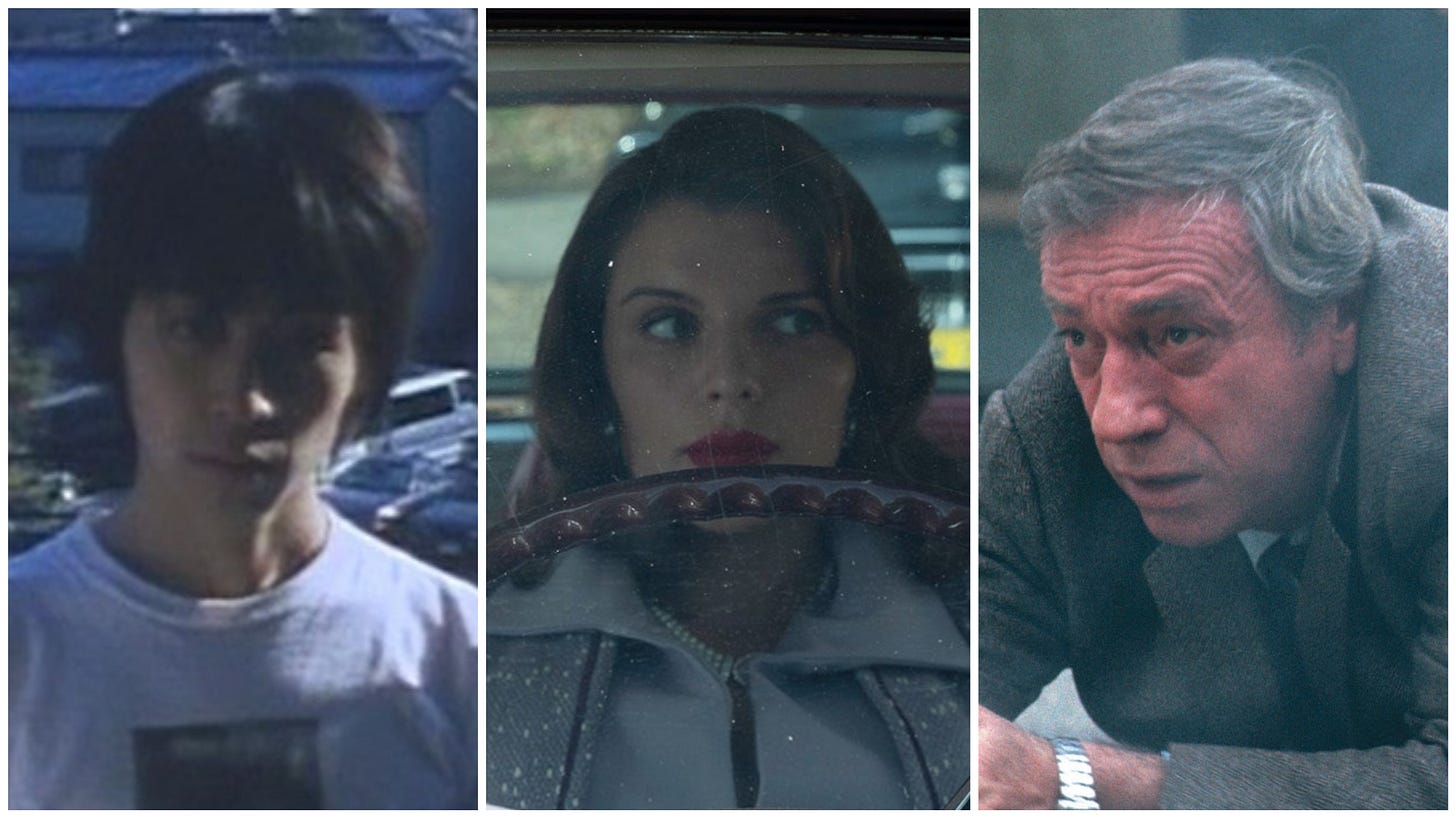Cinema Year '25: May Discoveries
Looking for an Angel / No Sudden Move / Police Python 357
Hello and welcome back to Cinema Year ‘25, a monthly review supplement. May’s discoveries offered us one of London’s finest festivals, a policier classic, and the possibility that Sodey’s goose is cooked.
Words by Ben Flanagan, Blaise Radley, and Tom de Lancy Green.
Don’t forget to subscribe to receive this and more film writing direct to your inbox.
Did you attend an interesting repertory film event this month and want to write about it? Get in touch yearzerocinema@gmail.com.
Looking for an Angel (Akihiro Suzuki, 1999, Japan)
A death march-like late-90s soundtrack of Japanese neo-psychedelia underscores the hour-long duration of Looking for an Angel. The new restoration of Akihiro Suzuki’s Japanese Queer Wave masterwork premiered at Queer East festival in London, which has become an unmissable part of the capital’s cinema calendar. Its surprising programming, including the British premier of Takeshi Kitano’s samurai thriller Kubi (2023), distinguish it as a festival with a distinct identity, even if the tote bags do awkwardly resemble those handed out by Sequoia Capital-funded Mubi.
In Looking for an Angel, two young gay men Shinpei (Akira Suehiro) Reiko (Hotaru Hazuki) learn of their friend Takachi’s (Kôichi Imaizumi) death. As they travel to the town where his body was found, their memories intermingle with home video footage to create a requiem swirl of mourning. Takeshi had been working in the porn industry, we soon learn. There’s no further mystery, only the sadness of wasted youth amidst a careless world characterised by oppressive industrial decay. On the fly handheld shots capture cityscapes as a transient blur of lens flare, while fisheye camcorder shots most commonly seen in skate videos are used to hone in on moments of melancholy reflection. Suzuki’s other films are as equally underseen, but continue this aesthetic expedition into a nostalgia of listless longing. Here’s hoping Looking for an Angel’s rediscovery brings them in front of more audiences, too. BF
No Sudden Move (Steven Soderbergh, 2021, US)
It’s hard to discuss the last decade of beloved Gen X workhorse Steven Soderbergh without coming off as a grouch—which is a pain because, in spite of my reservations, I broadly like his work. In a market where auteurs either become IP themselves or else slum it on for-hire jobs, Soderbergh’s all-in approach to directing, shooting, and editing original films on a tight budget announces itself as a potential antidote (or, more likely, just the exception that proves the rule). So, why are the end results so often middling?
The fine qualities that define Soderbergh’s late films—his constant experimentation with digital filmmaking techniques, his refusal to cow to Big Hollywood, his knack for pulling knotted performances out of genuine megastars—are all found in abundance in No Sudden Move, a witty crime thriller the type of which Soderbergh made his name on. Whether it’s the abrasive use of anamorphic lenses, such that nearly every frame is distended, or the cavalcade of game A-list and prestige TV actors, there’s a lot of fun to be had, particularly during the opening 30 as the criminal crew is rapidly assembled—and then dissembled as their scheme falls apart.
Soderbergh clearly draws a great deal of pleasure from these aspects of the filmmaking process, whether he’s fooling around with the warping effects of his wide lens or getting another major celeb to do some throwback noir scenery chewing. And that’s where the issues set in. It’s not goofing off, per se, but Soderbergh’s riffing lends No Sudden Move the air of an assembly cut, with every idea, every line, every winkingly convoluted plotline left in—no redrafts needed. I’d never question Soderbergh’s ability as an editor, but one wonders if in taking on so many roles at once, he’s lost the specificity needed to deliver a true banger. As it stands, we’re left with a run of films that are all good, but never great. BR
Police Python 357 (Alain Corneau, 1976, France)
We open with the gun, of course—the titular role. Like the film for which it becomes the icon, its logic is cold and inescapable. Inspector Ferro (an abject Yves Montand doing his best Mastiff impression), the sap holding onto the 357, is fossilised just minutes in. Captured mid-bust by prowling photographer Sylvia (Stefania Sandrelli) pointing his gun in portrait, he finds himself blown up to a giant poster in a fashion shop window. Fascinated by Sylvia—and perhaps a little gelded by that Modernist problem of your simulation being bigger than you—they begin an affair. Unknowingly, he has become her second lover—the first being his own Police Commissioner, Ganay (François Périer).
Ganay’s subsequent murder of Sylvia is riddled with coincidence pointing squarely at Ferro, although neither commissioner nor cop is aware at first of the other’s involvement. Their anxiety over a reversed panopticon is thus deferred from the personal into the systemic, each a phantom in the other’s waking nightmare. Ganay has a foothold, of course: his commands, however unwittingly, lead Ferro towards self-incrimination. Their chess game is mostly one of shadows and missed meetings, presaging a generation of Hong Kong cop thrillers by over a decade.
But the logic of the gun must out: point and shoot. Chekhov probably knew better than anyone that a gun is a delayed potentiality waiting to be actualised. In the surveillance state of Alain Corneau’s world (tactfully confined mostly to the warzone of the Parisian banlieues), it is only a matter of time before the 357 finds a body to invade. And this logic—the logic of the policeman—permeates the film, defines its cruelty. Turning the police state inwards, like Medusa in the mirror, breaks the bastard down. And cop solidarity still wins the day. TDLG



